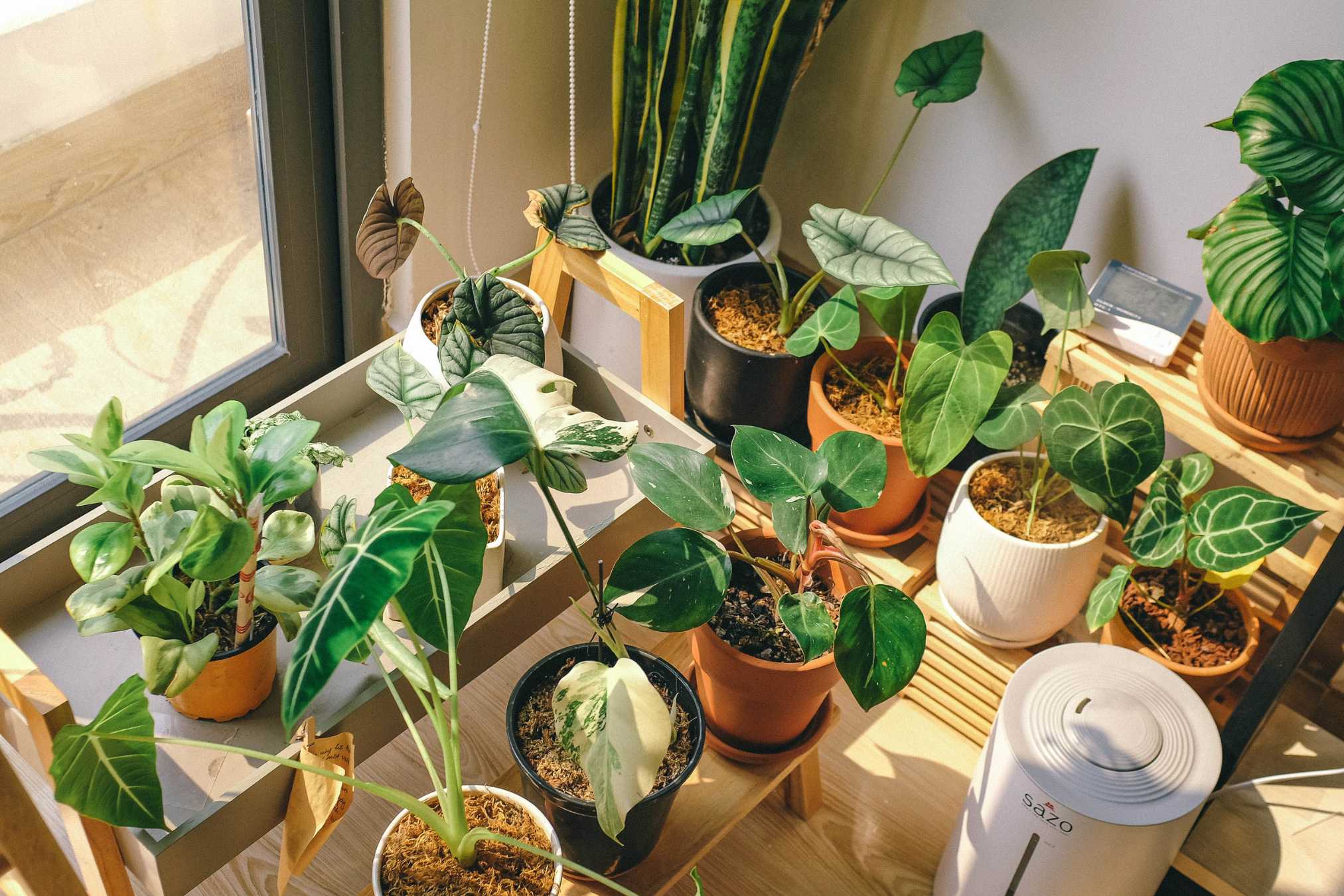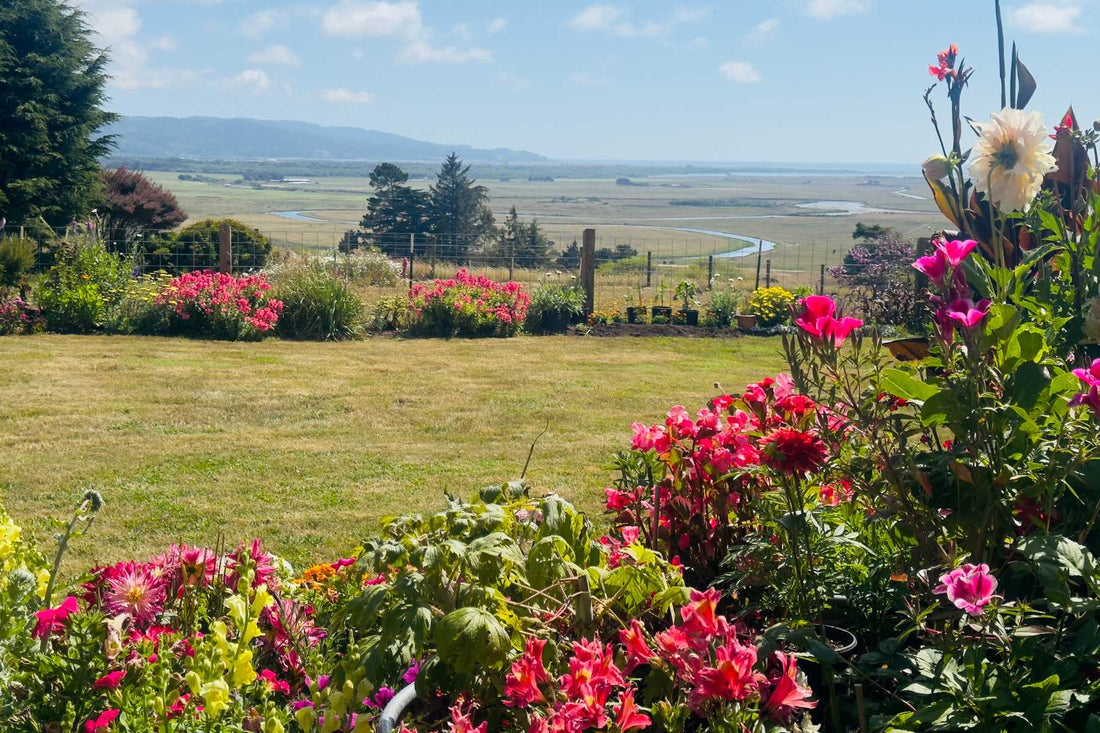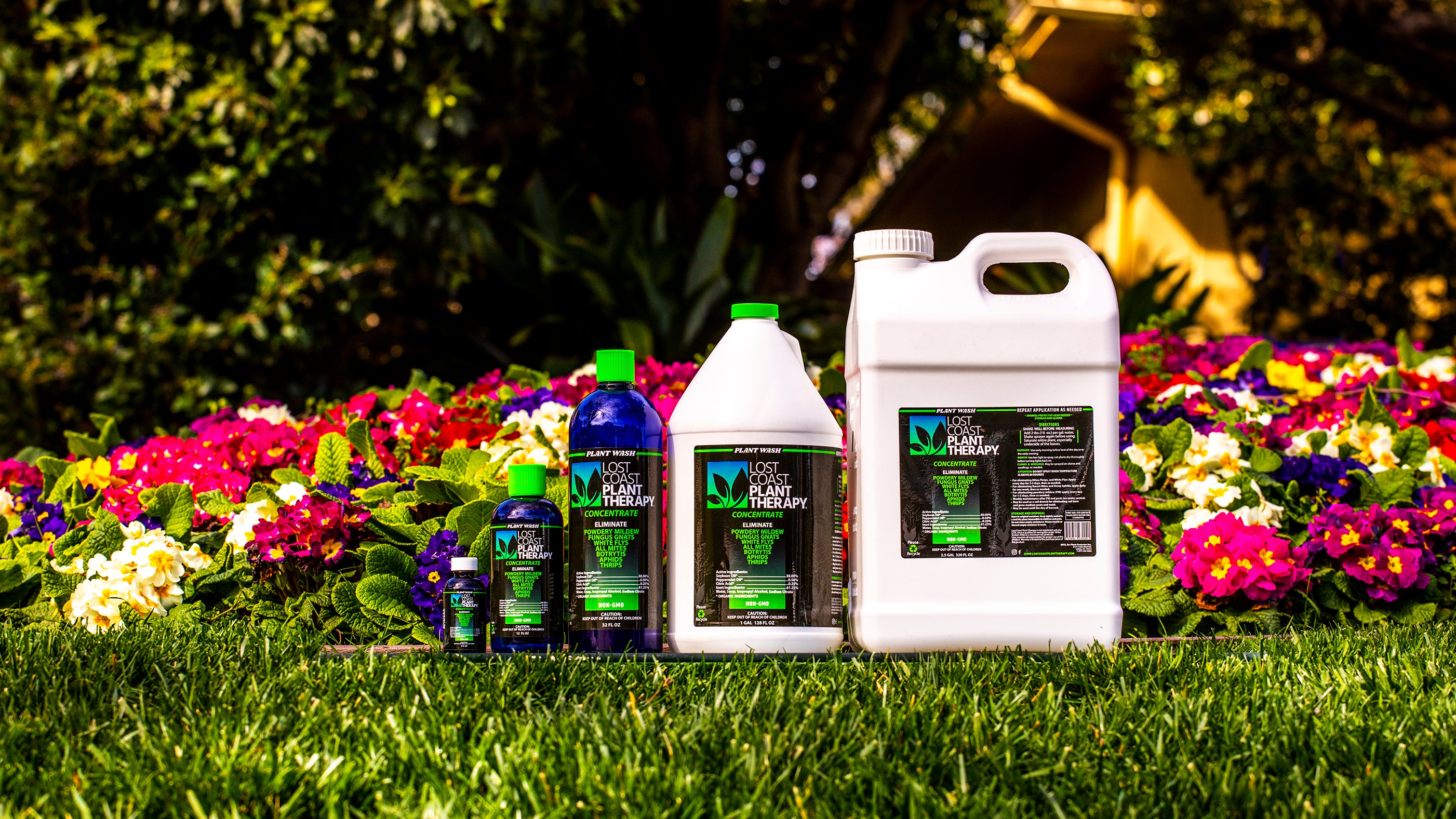If you’ve ever looked at one of your indoor plants and noticed something felt off, maybe the leaves weren’t as bright, a little sticky, or there were tiny specks you didn’t remember seeing before, you’re in familiar territory. Houseplant pests are extremely common. They show up in every home eventually, whether we’ve been growing plants for years or just brought home our very first pothos. It’s not a sign of bad plant care. Indoor environments are warm, cozy, and protected, and our plants are naturally full of sugars and moisture that many insects love. In other words, our homes provide exactly the kind of habitat these tiny pests seek out.
Over the years, we’ve learned that the key to managing pests is understanding them. Once we know what we’re looking at, why it happens, and what signals to watch for, the whole experience becomes much easier. We don’t need to panic or reach for harsh solutions.
When we do spot something early, we use Lost Coast Plant Therapy because it controls soft-bodied pests on contact without leaving behind residue. It supports the plant instead of stressing it, which helps everything stay healthier in the long run.

Houseplant Pest Identification: Understanding Common Indoor Plant Pests
Houseplant pests can arrive many ways. Sometimes they come home on a new plant from the nursery. Sometimes they appear after a stretch of overwatering. Sometimes they even find their way indoors through open windows during warm seasons. Once they’re in the home, they take advantage of the steady warmth and lack of natural outdoor predators. If we know where each pest tends to hide and how they feed, identifying them becomes much easier.

Aphids
Aphids are small, soft-bodied insects that usually gather in clusters. They’re drawn to the tender, newest parts of the plant such as fresh leaf tips and young stems. If you look closely, you might notice the youngest leaves curling, wrinkling, or appearing sticky. That sticky residue is called honeydew, which aphids leave behind as they feed. If honeydew is present, sooty mold may follow. Aphids multiply quickly, so noticing them early makes a big difference in how easily they can be controlled.
See how to get rid of aphids here.

Spider Mites
Spider mites are tiny and often hard to see without close inspection. Gently tap a leaf over a plain sheet of white paper. If tiny specks start crawling across the paper, that’s your confirmation.
A plant affected by spider mites may develop very fine pale spots across the leaf surface, almost like the color has been dotted away. If the infestation grows, delicate webbing may form between leaf veins and stems. Spider mites love warm, dry indoor air, which is why they’re especially common during winter heating seasons. They feed by sucking plant sap, which reduces plant health over time.
See how to get rid of spider mites here.

Fungus Gnats
Fungus gnats appear as small, dark, mosquito-like insects hovering around the plant or soil. While the flying adults are mostly an annoyance, the larvae living in damp potting soil are the real issue. They feed on decomposing plant material and sometimes plant roots. If a plant seems droopy or stressed even when watering seems correct, fungus gnat larvae may be affecting the root zone. Overwatering creates the perfect environment for them, so soil moisture rhythm is key to prevention.
If you’re not sure they’re present, place a thin slice of raw potato on the soil surface overnight. Fungus gnat larvae are drawn to the potato and gather underneath it, making them easier to spot and remove. You can also use yellow sticky traps around the plant to monitor adult activity. These traps won’t solve the issue on their own, but they help you see whether the population is increasing or decreasing, which is especially helpful when you’re tracking your progress.

If they are present, you can do a soil drench with Lost Coast Plant Therapy by mixing 1 oz per gallon of water and watering it gently into the soil, just enough to moisten the root zone rather than flood it. Used once a day for a few days and then spaced out as needed, this helps control the larvae in the soil while keeping the plant itself calm and supported.
Once soil moisture is balanced again, fungus gnats lose the environment they rely on, and the plant rebounds naturally.
See more on how to get rid of fungus gnats on houseplants here.

Mealybugs
Mealybugs are small white, cotton-like patches tucked into the joints of stems and leaves. Their bodies are coated in a waxy, protective layer, and they tend to hide in the folded, sheltered areas of a plant. A plant with mealybugs might feel sticky or appear to have dark sooty mold on its leaves due to honeydew. Plants with thicker leaves, such as jade plants and many succulents, are especially prone to mealybug infestations.
See how to get rid of mealybugs here.

Scale Insects
Scale insects look like small bumps or shells attached to stems and leaf veins. They can be flat or dome-shaped depending on the type. Even though scale insects appear immobile, they begin life as tiny, mobile crawlers that settle and anchor themselves. The plant may look like it’s slowly losing vigor. Leaves may yellow and feel thin, and the plant may seem tired without an obvious cause.
If you’re unsure whether you’re seeing scale or a natural part of the plant, gently use a fingernail to press on the bump. Scale insects lift or shift with light pressure, once you feel that texture once, you’ll instantly recognize scale in the future.

Whiteflies
Whiteflies are tiny, soft-bodied insects that flutter up when the plant is moved or touched. They feed on plant sap and gather on the underside of leaves. Over time, leaves may yellow, lose color, or develop a slightly silvery texture. Like aphids and mealybugs, whiteflies also produce honeydew, which can lead to sooty mold. They reproduce quickly, so noticing those first few adults early is helpful.
See how to get rid of whiteflies on indoor plants here.

Thrips, Broad Mites, and Russet Mites
Thrips, broad mites, and russet mites are some of the most frustrating houseplant pests because they are extremely small and rarely seen directly. Instead of showing up as visible insects, they change the texture, shape, and color of new growth. This makes them easy to overlook at first.
Thrips are slender, fast-moving insects that scrape plant tissue as they feed. On leaves, this feeding causes streaks, silvery patches, or tiny black specks (their waste). Flowers may open with streaked or faded petals. Thrips love new, tender growth, so we often notice the damage before we ever see the insects themselves. Running a clean finger gently across a leaf may even feel slightly rough or sandpapery. Thrips can move fast and travel from plant to plant easily.
See how to get rid of thrips here.
Broad mites and russet mites are even smaller than thrips, often invisible to the naked eye. Instead of dots or streaks, they cause deformed new growth. Leaves may emerge curled tightly inward, hardened, twisted, or unusually shiny. Sometimes the plant seems to be shrinking, with each new leaf appearing smaller and more distorted than the last. Because they feed on the newest tissue before the leaf has fully formed, the damage is most noticeable in the younger parts of the plant.
See how to get rid of russet mites here.
These mites also tend to hide deep in crevices, in areas close to the stem, or near buds. If the newest growth on your plant looks sad, cramped, or just wrong while older leaves look mostly normal, it’s often a sign of broad mites or russet mites rather than a watering or nutrient issue.

Immediate Action When You Find Pests
When you first notice pests, gently move the plant away from other houseplants, just enough distance that insects cannot easily travel from leaf to leaf. Then take a moment to look closely at all parts of the plant, the underside of leaves, along the stems, and the top layer of the potting soil. Sometimes just rinsing the plant gently in the sink or shower helps remove a large number of insects right away, especially tiny insects like aphids and spider mites.

After rinsing, allow the plant to dry slightly and apply Lost Coast Plant Therapy. Thorough coverage matters. When spraying the plant, we make sure to coat the entire plant, stems, leaf surfaces, and especially the undersides where pests hide and lay eggs.
Make sure to continue checking the plant every couple of days. Many pests lay eggs that hatch in cycles, which means one treatment rarely controls the entire population. Gentle, repeated care is how we support the plant back to strong, healthy growth.

Using Lost Coast Plant Therapy for Control
Lost Coast Plant Therapy is designed to control soft-bodied insects through simple, physical contact action. When the product is sprayed onto the insects, it coats them and begins to disrupt their ability to feed and function by suffocating and dehydrating soft surfaces.
Because it works through contact instead of harsh chemical absorption, it does not rely on systemic action or leave harmful residue on the plant. It is made with natural and organic ingredients, is biodegradable, and is considered a minimum risk pesticide, which means it is gentle enough to use on indoor plants and even edible or medicinal plants when used as directed.
Standard Dilution (1 oz per Gallon)
For regular use or early signs of pests, mix 1 ounce of our concentrate into 1 gallon of water. This strength is generally enough to control common pests like aphids, spider mites, mealybugs, whiteflies, and scale insects when applied thoroughly and regularly. Shake the bottle before measuring, mix well into clean water, and shake the sprayer gently every few minutes during application for best coverage.
Boosting Strength (2 oz per Gallon When Needed)
If the infestation is more stubborn, especially with pests like thrips, russet mites, or hemp aphids, it can help to temporarily increase to 2 ounces per gallon for one or two applications. After the plant begins to recover, return to the standard dilution to maintain balance. Boosting is something we use purposefully and thoughtfully, always test on a small part of the plant before applying widely.

Soil Drenching for Fungus Gnat and Root-Zone Pests
For pests that live within the potting soil, such as fungus gnat larvae, use the same dilution of 1 ounce per gallon and pour the mixture slowly through the soil. Do this for a few days in a row while also allowing the top layer of soil to dry slightly between waterings. This helps interrupt the life cycle in the root zone and reduces the larvae population without harming the plant roots.
See How it Works here and Instructions here.

Creating a Pest-Resistant Indoor Microclimate
A big part of managing common houseplant pests has to do with the environment we keep our indoor plants in. Most insects and mites take advantage of stress, dryness, stale air, or soil that stays wet for too long. A comfortable indoor environment for plants naturally encourages strong growth, which makes the plant harder for pests to feed on. These small adjustments help reduce plant stress and make our indoor spaces less welcoming to insects on indoor plants.

Airflow
Good airflow helps keep leaves dry and discourages pests that prefer still, stagnant air. A small fan running on low nearby, or even just opening a window when the weather is mild, keeps air circulating. This also helps slow powdery mildew and sooty mold that can develop when humidity sits on leaf surfaces without moving.

Humidity
Humidity balance matters because different pests like different levels of moisture. Spider mites thrive when the air is dry, while fungus gnats thrive when soil stays constantly damp. The goal is to find the middle ground. Allow the potting soil to dry slightly between waterings so fungus gnat larvae can’t develop easily, and if your home is very dry, adding a little humidity helps prevent spider mite outbreaks.

Light
Plants growing in the right amount of light develop stronger, thicker leaves that are less appealing to sap-sucking insects. If a plant is stretching or looking pale, it may not be getting enough light, which makes it more vulnerable to pests like aphids, whiteflies, and thrips. Seeing how a plant reacts to its light and adjusting its placement can prevent repeating cycles of pest-related plant stress.

Temperature
Steady indoor temperatures help prevent stress. Sudden temperature shifts, especially hot, dry heating airflow during winter, can lead to weakened leaves and faster mite reproduction. Plants generally do best when temperatures stay between roughly 65–78°F. When plants feel steady and supported, they are less likely to face repeated pest infestations.

Quarantine and Clean-Up Practices
One of the simplest ways to prevent the spread of pests on houseplants is to give every new plant a short quarantine period. When you bring home an exciting new plant from garden center, it may look healthy at first glance, but tiny insects or eggs could still be hiding under leaves or along stems. Setting the plant aside in a separate spot for about ten to fourteen days will give you time to observe it closely and apply our Natural Plant Wash before integrating it into our main plant area.

Sanitizing tools between plants is another great habit to have. Clippers, cotton swabs, repotting scoops, and moisture probes can unknowingly carry pests or fungi from plant to plant. A quick wipe with rubbing alcohol keeps tools clean. The same applies to pots and trays, rinsing them with warm water and a gentle soap before reuse helps prevent eggs and larvae from continuing their life cycle.

How to Identify Houseplant Pest Problems Early
Plants rarely go from healthy to struggling overnight. Most signs of pests start as very small changes, a shift in leaf texture, a slight dullness in color, or a new leaf that just doesn’t look quite right. Plants communicate through their leaves and stems. Being able to read these signals helps us understand whether the issue is related to pests, watering, or something else.

Yellow Leaves
Yellow leaves can happen for many reasons. When pests are involved, the yellowing often appears as speckling, patchy fading, or thinning along the veins. If the yellowing is more uniform across the entire leaf, it may be related to watering rhythm or nutrients instead of insects. Feeling the soil can help us differentiate. If potting soil is consistently wet, the issue may be too much water. If the soil is extremely dry, the plant may be stressed and more vulnerable to insect pests.

Drooping or Wilting
Drooping leaves may mean the plant needs water, but drooping can also happen when the roots are affected by fungus gnat larvae or early root rot. If the plant is drooping even when the soil is moist, it may be helpful to loosen the top of the soil slightly and observe its smell. Healthy soil smells earthy. Soil that has gone anaerobic smells sour or stagnant. Steady watering rhythms and occasional soil drenching with our Natural Plant Wash can help keep the root zone healthy.

Sticky Leaves
Sticky leaves almost always indicate honeydew, the sugary residue from insects like aphids, soft scale, whiteflies, or mealybugs. If we see sticky leaves, it’s time to look closely along stems and the underside of leaves, where these insects often hide. Washing the sticky residue away and treating the plant gently but consistently helps the plant breathe again.

When It’s Not Common Pests
Not all plant issues are caused by insects. Sometimes the problem comes from the environment around the plant rather than from pests. Mold can grow on the surface of soil when it stays damp for too long. Mildew can form on leaves when the air is still and humid. And when roots are kept wet without enough airflow in the soil, root rot can develop. These issues can sometimes look like pest problems, but they’re rooted in moisture and airflow rather than insects.
Mold on soil can often be managed by improving airflow and letting the top layer of soil dry between waterings. Keeping watering rhythms steady helps prevent excess moisture from settling at the surface where mold thrives.

Powdery white surfaces on leaves can be powdery mildew, which appears in humid or stale air environments. Sometimes dust can mimic this look, but mildew tends to spread on its own and look velvety or patchy. Our Natural Plant Protector can be sprayed to wash the powdery surface away while also adjusting the leaf surface pH to be less inviting for mildew to return.
See more on how to get rid of powdery mildew here.
Root rot requires time and patience. When roots stay wet for too long, they lose access to oxygen and begin to break down, which can weaken the entire plant. Allowing the soil to dry more thoroughly, improving drainage, and sometimes repotting into fresh, well-draining soil will help support recovery.

Preventing a Future Pest Infestation
Prevention is about rhythm. A weekly plant check is one of the most valuable habits we can form. Picking up the plant, turning the leaves gently, and simply looking with attention helps us catch changes before they grow. During these checks, spraying with Lost Coast Plant Therapy once every 7 to 10 days during active growth can help support the plant surface and make it less inviting to pests.

Repotting hygiene also matters. When we repot, shaking away old soil and starting fresh helps reduce hidden eggs and larvae. Watering practices play a large role too. Allowing the soil to dry a bit between waterings keeps fungus gnats from laying eggs and strengthens plant roots.

Pest-Resistant Houseplants
Some houseplants are naturally more resistant to pests because their leaves are either thicker, waxier, or less appealing to sap-sucking insects. Plants like snake plants, ZZ plants, pothos, and philodendron varieties often stay pest-free longer because their leaf structure is more resilient and less attractive to feeding. This doesn’t mean they never get pests, only that they tend to resist infestations more successfully and recover more easily.
See 18 best low light indoor plants to grow year round here.

Conclusion
Every indoor plant grower deals with pests at some point. What really makes the difference is noticing changes early and responding steadily rather than reacting with panic or harsh products.
The approach we’ve shared here is meant to support both the plant and the home environment. Checking plants regularly, adjusting watering habits, making small improvements to airflow and light, and treating gently with our Natural Plant Protector can help keep your houseplants healthy and resilient over time.
Lost Coast Plant Therapy works by controlling soft-bodied insects on contact without disrupting the plant’s natural balance. It’s made with natural and organic ingredients and is safe to use around kids, pets, and in the home when used as directed, which makes it easy to include as part of a consistent weekly plant care routine.
The more we observe our plants, the more confident we become in understanding what they need. Over time, you’ll start to recognize small signs before they become bigger issues, and that’s really the key to managing pests indoors. It’s not about being perfect, it’s about being present and consistent.

FAQ's
What are the most common houseplant pests I should look for?
Some of the most common houseplant pests include spider mites, aphids, mealybugs, scale insects, thrips, whiteflies, and fungus gnats. Many of these pests hide on the underside of plant leaves or along stems where it’s easy to miss them at first. The key to managing pests is learning how each one behaves and checking your plants regularly so you can respond early.
How do I tell if my plant is healthy or starting to get infested?
A healthy plant usually has firm, vibrant leaves with a natural shine. When insects begin to infest a plant, you may notice dullness, tiny speckles, sticky leaf surfaces, webbing, or stunted plant growth. If something looks off, gently inspect the plant leaves (especially the undersides), stems, and the top layer of soil.

Where do insects on indoor plants usually hide?
Most houseplant insects prefer protected places. Look in the joints where stems meet leaves, on the underside of leaves, along new growth, and sometimes within the potting soil itself. Scale insects especially can blend in with the plant surface and may look like tiny bumps or a white appearance on stems.
How do I deal with insects on a plant that live in the soil, like fungus gnat larvae?
Soil-dwelling pests are managed by adjusting watering rhythm and using a soil drench. When a product is watered into the soil, it can help kill fungus gnat larvae directly. Allowing the top layer of soil to dry out between waterings also makes the soil less attractive to fungus gnats so they don’t return.

What is the key to managing pests on houseplants effectively?
Consistency. Instead of one strong treatment, gentle repeated care works best. Wash the plant first to remove dust and insects you can see. Then apply a contact treatment like our Natural Plant Protector thoroughly to all plant parts, including the underside of leaves. Reapply on schedule because many pests lay eggs that hatch in cycles.
Should I discard the plant if it’s badly infested?
Most of the time no, pests can be controlled with steady care. The only time we recommend discarding the plant is if it is extremely weakened, collapsing at the root level, or has a severe disease spreading from the soil. Even heavily infested plants can recover if treated.

What about pests like scale, they don’t move, how do I treat them?
Adult scale insects stick to plant parts and feed without moving, but they start life as tiny crawlers that spread. Washing the plant gently and treating with Lost Coast Plant Therapy works well because it can affect both the adults and any young crawlers present. Consistency is key, since many of these pests reproduce in cycles.
Can pests cause plant diseases?
Yes. Pests that suck plant sap, like spider mites, aphids, thrips, and scale, can cause many plant problems by weakening growth and making the plant more vulnerable to disease.

What’s the best ongoing routine to keep a healthy plant and prevent pests from returning?
Check your plants weekly, gently wash the leaves when they look dusty, allow the potting soil to dry slightly between waterings, and make sure there’s good airflow around them. Applying Lost Coast Plant Therapy as part of that routine can also help control pests and prevent them from returning to your houseplants.
See more FAQ's here.

Additional Resources
Managing Insects on Indoor Plants – University of Minnesota Extension
Diseases, Disorders & Insect Pests (Houseplants) – University of Wisconsin–Madison Horticulture
Indoor Plant Insects – University of Maryland Extension
Fungus Gnats in Indoor Plants – Penn State Extension
Spider Mites and Their Control – Ohio State University Extension (Ohioline)
Houseplant Problems (Home & Landscape) – UC ANR Statewide IPM
Common Houseplant Insects & Related Pests – Clemson University HGIC
Fungus Gnats as Houseplant and Indoor Pests – Colorado State University Extension
Pest and Disease Problems of Indoor Plants – Penn State Extension
Diagnose Indoor Plant Problems – University of Maryland Extension






